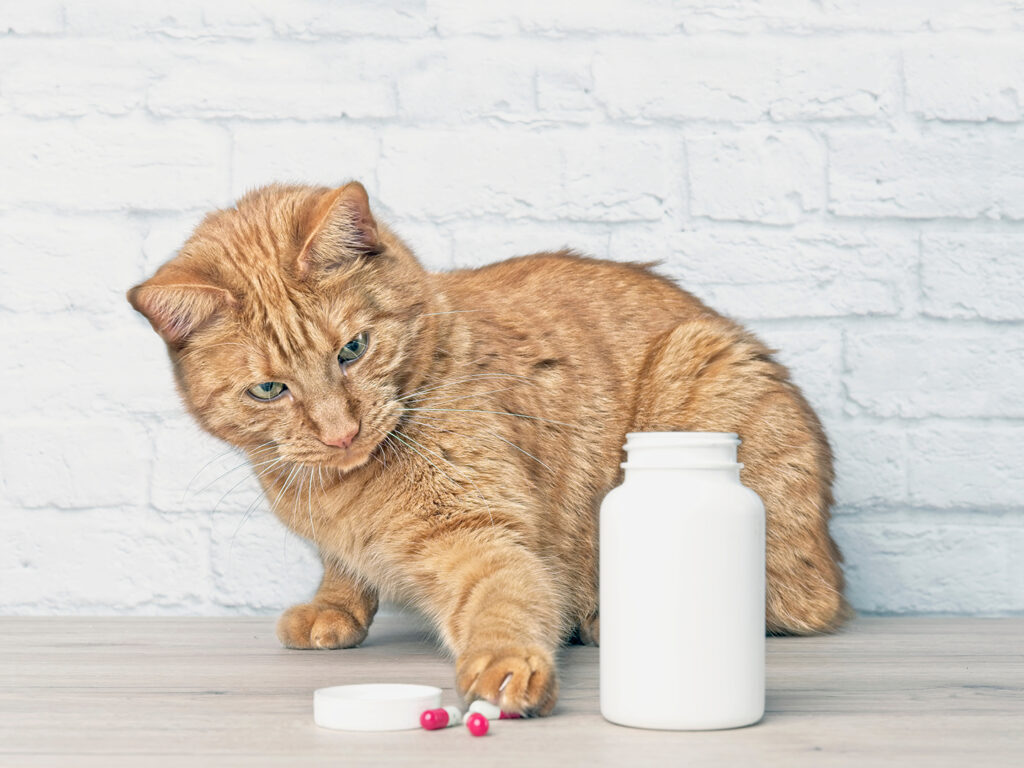Preventing Pet Intoxication

Our furry friends have curious natures, and even though we try our best to keep them safe and healthy, they may still get into trouble when they unknowingly eat human medications or other common household items that are toxic to them.
Dr. Christine Rutter, a clinical associate professor of emergency medicine at the Texas A&M School of Veterinary Medicine & Biomedical Sciences, emphasizes the dangers of pets ingesting household toxins and outlines how owners can protect their pets.
Common Household Toxins
Contrary to popular belief, Rutter says it is more common for pets to become intoxicated by human, pet, and recreational medications than household cleaners and pesticides.
“Over-the-counter pain medications, prescription painkillers, vitamins, antidepressants, and stimulant/recreational medication exposures are very common,” Rutter explained. “Medication exposure usually happens because of dropped medication or when a pet has access to a bottle or a bag containing the medication.”
Because of the size difference between people and most pets, it is extremely dangerous for pets to ingest human medications. According to Rutter, even one dose of a human medication can cause dogs and cats to have significant exposures.
But medications are not the only way for pets to become intoxicated.
“Because so many households keep ornamental plants or aren’t familiar with the toxicity of certain cut flowers, toxic plant exposure is also common, with symptoms ranging from mild discomfort and gastrointestinal upset to life-limiting organ failure,” Rutter said. “Even common foods – chocolate, grapes, raisins, onions, peppers, and macadamia nuts – and artificial sweeteners can be toxic for pets.”
Varying Symptoms And Treatments
It can be difficult for owners to recognize intoxicated pets because symptoms vary greatly and are not easily noticeable.
“Symptoms of pets ingesting toxins can be anything – including altered mentation, or any change in normal behavior, which can include excitability, anxiety, compulsive behavior, decreased consciousness, or apathy to their surroundings; drooling; seizures; tremors; weakness; excessive thirst; vomiting; or abnormal bleeding or bruising,” Rutter said. “Some toxins will have delayed onset of clinical signs, which means that the owner would not likely notice any changes in their pet for up to 10 days. In some cases, the delay is too late to prevent permanent organ damage.”
Because symptoms are not easy to recognize, Rutter strongly encourages owners to be overly cautious if they suspect their pet has eaten or come in contact with something that may be toxic to them. She encourages owners to consult with their veterinarian sooner rather than later.
“Initial testing will likely include a physical examination, blood testing, possibly urine testing, and sometimes drug screening,” Rutter explained. “Your veterinarian will not report your pet’s intoxication to authorities, even if illegal substances are involved. Veterinarians are only interested in treating your intoxicated pet, so please be honest.”
Medical exams also will be necessary to determine the best course of treatment.
“Treatment is going to vary widely depending on the intoxication since the type of intoxication, the amount ingested, and an animal’s size all impact the severity of the intoxication,” Rutter said. “Some intoxications require intensive care while other intoxications can be treated with less intense care or even outpatient therapy.”
Prevention Is All About Awareness
It is nearly impossible to remove all medications, plants, and foods that are toxic to pets from a home, so prevention must start with awareness.
“Owners should know the names and toxicity level of any plants in the house or yard; for example, sago palms, true lilies (for cats), yew plants, and some mushrooms can be extremely toxic,” Rutter said. “Also know that the active ingredients in rodenticide can remain active indefinitely and that some artificial sweeteners (particularly xylitol) are very toxic to dogs, which can be found in certain health foods, sugarless gums, and sugar-free and keto baked goods and sweets.”
Rutter also suggests owners only handle medications in areas away from a pet’s environment, keep animals in a safe place away from recreational medication use – especially if people are participating in such activities in the pet’s home or yard – and store all medications in bags or bottles out of a pet’s reach.
“It’s ironically difficult to give dogs and cats pills, but, somehow, there are medications that they will ingest readily if they get access to it,” Rutter said. “Some pets will rip into backpacks or even open containers to get medications. Even a dropped pill can be a significant hazard to pets, and we have all dropped medicine accidentally.”
Lastly, Rutter recommends pet owners familiarize themselves with poison control guides from the American Society for the Prevention of Cruelty to Animals, which includes a hotline that owners can call for help when determining if their pet has ingested a toxic item.
Since medications, plants, and food are meant for human consumption or enjoyment, owners should take measures to ensure that humans are the only ones that can use them.
Pet Talk is a service of the School of Veterinary Medicine & Biomedical Sciences, Texas A&M University. Stories can be viewed on the web at vetmed.tamu.edu/news/pet-talk. Suggestions for future topics may be directed to vmbs-editor@tamu.edu.


